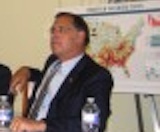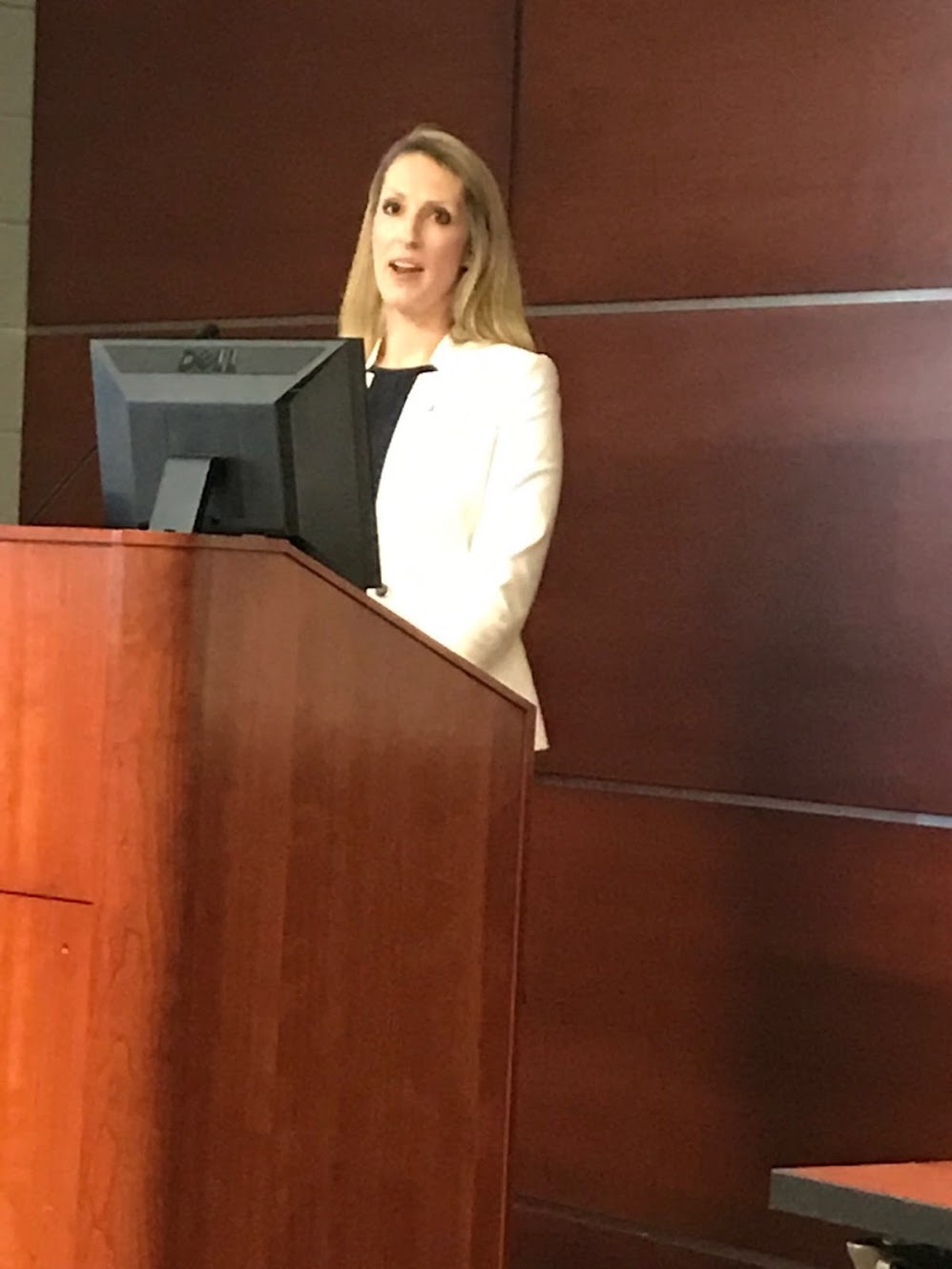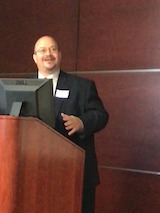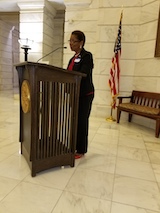Economic Equality Caucus
which advocates for economic equality across the USA.
| Home | Organizational Structure | State Coordinators | Executive Director | Caucus Articles | Memberships | |||||
| "Delta Vision, Delta Voices" | ||||||||||
|
Help Advocate for Economic Progress and Equality. Donate to the Delta Caucus/Economic Equality Caucus. |
||||||||||
Delta Grassroots Caucus Events

Credit Michael Hibblen/ KUAR News, Arkansas Public Radio; Former President Bill Clinton speaking to the Delta Grassroots Caucus on May 2, 2013, at the University of Arkansas Clinton School of Public Service, Little Rock

U. S. Senator John Boozman, Arkansas, at a Delta Grassroots Caucus meeting at the US Capitol

Brad Cole, Executive Director of the Municipal League of Illinois; previously a senior aide to former Republican US Sen. Mark Kirk of Illinois, earlier Mayor of Carbondale, Illinois, veteran Delta regional advocate, speaking at the Delta regional conference in West Memphis, Arkansas on April 26, 2019.

President Bill Clinton makes a comment to Delta Caucus Director Lee Powell at a meeting in Blytheville, Arkansas (in the northeast Arkansas Delta) on Nov. 2, 2014

The Delta Caucus would like to pay tribute to the late, great U.S. Sen. Thad Cochran of Mississippi, a powerful force in the US Senate for decades and a champion for the Delta. Sen. Cochran passed away on May 30, 2019. He spoke to the Delta Caucus on many occasions over the years (he is pictured above speaking to a Caucus event on Capitol Hill in Washington, DC) and his thoughtful, courteous and bipartisan leadership will be sorely missed.

Marcie Lawson, Executive Director, Sikeston, Missouri Regional Chamber and Area Economic Development Corporation, speaking at the Delta regional conference in West Memphis, Arkansas on April 26, 2019.

Alan Gumbel, Greater Memphis Alliance for a Competitive Workforce, Memphis, Tennessee, speaking at the Delta regional conference in West Memphis, Arkansas on April 26, 2019.

Mayor Shirley Washington of Pine Bluff, AR, speaking to the Delta Caucus at the Arkansas Capitol Rotunda in 2017.
2009 Is Crucial for Interstate 69--Please Contact Your Members of Congress for I-69
Posted on May 01, 2009 at 10:48 AM
The completion of the Interstate 69 Corridor would have major benefits for the economic development of the Greater Delta Region as well as America’s transportation system as a whole. This year’s highway bill will mark an historic opportunity in the development of this vital transportation artery, so we include detailed information on it in this message. Thanks to the Delta states’ Congressional delegations of Arkansas, Mississippi, Tennessee and Kentucky—through which I-69 will run–and Carolina Mederos of Patton & Boggs firm in Washington, DC, and the I-69 Mid-Continent Highway Coalition for providing this information.
Congress is drafting the highway bill now. The House and Senate will both vote on it and then will have to resolve any differences in the two versions. So we would expect from now on through the summer and early fall would be key periods when we would need to stay in touch regularly with the Congressional delegations and urge them to make substantial progress on I-69 this year. This is most important for the Arkansas, Mississippi, Tennessee and Kentucky delegations, so please contact your Representatives and Senators now and throughout this vital debate.
Recently meetings were held in Washington, DC, Tennessee, Arkansas and other locations to promote progress on I-69. The Delta Grassroots Caucus will make advocacy for I-69 one of our top priorities this year, so please look over this information and contact your Congressional delegation as soon as possible.
It is of course impossible to say exactly when all the various steps will take place to the final moment when both Houses have passed it and President Obama signs it into law. It could be that the debate will be entering its climactic stages at the time of our annual Delta Initiative in Washington, DC, set for September 15, 16 and 17, 2009. I-69 will go through northwestern Louisiana, southeastern Arkansas, will traverse the Mississippi by the Great River Bridge, continue through Mississippi, western Tennessee and western Kentucky and then to Canada. (Information on the Sept. 15-17, 2009 Washington, DC conference is on our website at www.mdgc.us.) But the September conference is just the culmination—AGAIN, PLEASE CONTACT YOUR CONGRESSIONAL DELEGATIONS NOW!
The combination of the highway bill and the need to generate economic growth to combat the recession make 2009 a crucial year in the long-awaited efforts to make major progress on I-69.
I-69 IS ONE OF ONLY SIX NATIONAL “CORRIDORS OF THE FUTURE”: A major step forward for I-69 took place in September, 2007, when the U. S. Department of Transportation (USDOT) named the I-69 corridor as one of only six national Corridors of the Future. According to Dan Flowers, Arkansas State Highway and Transportation Department Director and Chairman of the eight-state Interstate 69 Steering Committee, that action was “an extremely significant step for the development of I-69,” stated Flowers. “The other corridors named are Interstate highways that are already in existence. The majority of I-69 is yet to be built. This is certainly a confirmation of the need for this highway and the nationwide safety, mobility, freight movement, and economic benefits that can be derived from its construction.”
Interstate 69 begins at the U.S./Canadian border north of Detroit and extends southward to Indianapolis. The corridor is then in various stages of development and construction from Indianapolis south through Kentucky, Tennessee, Mississippi, Arkansas, Louisiana, and Texas before reaching the Mexican border near Laredo.
A fact sheet is included below. Let’s all focus on getting a high profile and levels of support for completion of I-69. Lee Powell, MDGC (202) 360-6347
FACT SHEET ON I-69 CORRIDOR:
I-69 will span America’s heartland: Designated as congressional High Priority Corridors 18 and 20 in the Intermodal Surface Transportation Efficiency Act of 1991, as a future part of the Interstate System in the National Highway System Designation Act of 1995 and as Interstate Route I-69 in the Transportation Equity Act for the 21st Century, I-69 traverses 111 counties and hundreds of municipalities, directly serving over 23 million people. When completed, it will span the nation’s heartland, connecting Michigan, Illinois, Indiana, Kentucky, Tennessee, Mississippi, Arkansas, Louisiana and Texas.
Construction to date: Two sections of High Priority Corridor 18 – I-69 from Port Huron, Michigan at the Canadian border to Indianapolis, Indiana and I-94 from Port Huron southwest to Detroit and west to Chicago, Illinois – were completed and opened to traffic under the Interstate Construction Program which ended in 1995. The first section completed without Interstate Construction funds opened in Mississippi in October 2006. The rest of I-69 is under development. From Indianapolis south, Corridor 18 connects Evansville, Indiana, Memphis, Tennessee, Mississippi, Arkansas, Shreveport/Bossier City, Louisiana and Houston, Texas to the Lower Rio Grande Valley at the Mexican border. Corridor 20 extends from Laredo, Texas at the Mexican border through Houston to Texarkana, Texas and overlaps part of Corridor 18. Together, Corridors 18 and 20 comprise I-69.
I-69 follows north-south flow of trade: When the Interstate System was initially designed, it was laid out generally east to west, reflecting the demographics, trade patterns and defense needs of the time. Trade has shifted from east-west to north-south. Today Canada and Mexico are our largest export markets, at $261.4 billion and $151.5 billion respectively. Together they account for more overall U.S. trade than our next five top trading partners combined. Trade with Canada and Mexico increased 225% from $297 billion in 1993 to $964 billion in 2008 with surface transportation trade reaching a record $830 billion. I-69 has the nation’s busiest border crossings on both borders, accounting for 52% of the nation’s truck trade with Mexico and 46% with Canada.
It is a key corridor for domestic freight movement. For example, corn from Indiana and cotton from Mississippi are trucked to the Rio Grande Valley, made into soft drinks and textiles and trucked back along I-69 to consumers. Automobile parts, electronics, computers, batteries and plastics manufactured in Texas are trucked to facilities in Michigan, Indiana and Illinois for final assembly and then back down I-69 for distribution to consumers.
I-69 will promote economic development while reducing fuel consumption, travel time, emissions and costs: Yet there is no direct Interstate highway from Michigan to Texas. Completion of I-69 will significantly enhance safety and efficiency along this key freight route. Completion of Corridor 18 alone is projected to save 3100 lives, avoid 158,000 injuries and 409,000 property damage accidents. I-69 will reduce travel time, fuel consumption, emissions and costs, while easing congestion on existing circuitous routes. Completion will reduce trip time between Port Huron, Michigan and Laredo, Texas by 8 hours.
I-69 is an essential intermodal link for trade and commodity flow. Seventeen of the nation’s top 25 seaports are directly connected to I-69 and 15 of the nation’s top 25 air cargo airports are readily accessible to I-69. Feasibility studies have shown positive cost benefit ratios for both Corridors 18 and 20, returning $1.57 and $1.68, respectively, for every dollar invested.
Completion of I-69 will promote economic growth in some of America’s most economically distressed regions: In addition to facilitating national freight movement and enhancing U.S. global competitiveness, I-69 will stimulate economic growth. I-69 traverses some of the nation’s most impoverished regions. There are over 10.5 million people living below the poverty level in the I-69 Corridor states. In seven of the Corridor states the population in poverty exceeds the U.S. average. There are 13 empowerment zones, enhanced enterprise communities and enterprise communities along the Corridor, including two rural empowerment zones - Mid-Delta and Lower Rio Grande Valley. Construction of I-69 will provide economic growth.
Costs of completion: The I-69 System spans over 2600 miles. About 2000 miles from Indianapolis to the Mexican border remain to be completed. Completion of I-69 will not require an entirely new facility. In some areas it will link existing Interstates or highways at Interstate standards. In other areas it will require upgrading and linking existing non-Interstate highways and in others new construction. Work is underway along the entire I-69 corridor, ranging from environmental studies to construction. Many sections are in design, right-of-way acquisition and construction and have completed – or are about to complete – Records-of-Decision. The cost of completing I-69 is approximately $24 billion. Kentucky through Louisiana can be completed and Indiana and Texas significantly advanced in the period of this reauthorization for approximately $14 billion.
While most of the Interstate System was built through the federally funded Interstate Program, the Program’s termination in 1995 left the I-69 states trying to construct this national asset without dedicated federal funds. The cost of completing I-69 exceeds the federal-aid formula apportionments of the I-69 states, so that even if they used all their eligible federal formula funds for I-69 and did no other work, they would not have enough funds to complete it. The I-69 Coalition has been a major proponent of dedicated federal funding for projects that, because of shifts in trade patterns, freight movement and demographics, are necessary to serve the transportation needs of the 21st Century.
Collaboration between I-69 coalition and the I-69 Congressional delegation: Working closely with the I-69 congressional delegation, the Coalition helped secure $476 million in federal authorizations, appropriations and grants for I-69 in the years prior to the enactment of the Safe Accountable Flexible Efficient Transportation Equity Act: A Legacy for Users. That Act provided another $538 million, bringing the total in federal funds to almost $1.3 billion, including match. I-69 states have also used non-federal funds and innovative financing. Indiana is using $694 million of the proceeds from the Indiana Toll Road lease to construct part of I-69. Mississippi used casino taxes and bonds to pay for its open-to-traffic section. These funding mechanisms have generated $1.2 billion, bringing the total committed or invested to date on I-69 to $2.5 billion.
The U. S. Department of Transportation selected I-69 as one of six national Corridors of the Future and awarded the I-69 states $800,000 to study innovative financing – including tolls, public private partnerships and Transportation Infrastructure Finance and Innovation Act loan options – to develop, construct, maintain and operate the Corridor. It is likely that innovative financing will not be appropriate for all of I-69 and that dedicated federal funds will be needed. The National Corridor Infrastructure Improvement and Projects of National and Regional Significance programs provide existing frameworks and the National Surface Transportation Policy and Revenue Study Commission has proposed Freight Transportation as one of ten federal program categories. It will probably take a combination of resources – federal, state, public and private – to complete this national asset.
The I-69 Mid-Continent Highway Coalition is a dues-paying organization of cities, counties, states, business, labor and civic organizations all along the I-69 Corridor. Many members of the Mississippi Delta Grassroots Caucus are also members of the I-69 Mid-Continent Highway Coalition.
I-69 supporters include over 45 Chambers of Commerce representing over 13,050 businesses. It reflects the economic diversity of this vast region, including the agriculture, mining, timber, energy, transportation, chemical, electronic and industrial sectors – current and future users of the I-69 Corridor. The Coalition has consistently advocated funding for I-69 before Congress and at the Department of Transportation and spearheaded the creation of the National Corridor and Coordinated Border Infrastructure programs.
The I-69 coalition has often expressed appreciation for Congressional committees’ continued support of I-69 and has requested that, as Congress develops a new federal framework, it include a dedicated funding mechanism to complete I-69, a key national freight corridor and intermodal link essential to enhancing U.S. global competitiveness in the 21st century.
One excellent source for for further information and details is:
Carolina L. Mederos, Patton Boggs LLP
(202) 457-5653
cmederos@pattonboggs.com
Back to the top